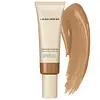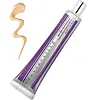Laura Mercier Tinted Moisturizer Natural Skin Perfector SPF 30 Versus Chantecaille Just Skin Tinted Moisturiser SPF 15
What's inside
What's inside
 Key Ingredients
Key Ingredients

 Benefits
Benefits

 Concerns
Concerns

 Ingredients Side-by-side
Ingredients Side-by-side

Ethylhexyl Methoxycinnamate
UV AbsorberEthylhexyl Salicylate
UV AbsorberWater
Skin ConditioningDisiloxane
Skin ConditioningPEG-30 Dipolyhydroxystearate
EmulsifyingC12-15 Alkyl Benzoate
AntimicrobialEthylhexyl Palmitate
EmollientGlycerin
HumectantIsohexadecane
EmollientCyclopentasiloxane
EmollientPhenoxyethanol
PreservativeBoron Nitride
AbsorbentJojoba Esters
EmollientMagnesium Stearate
Cosmetic ColorantSodium Dehydroacetate
PreservativeSqualane
EmollientLauryl PCA
HumectantTocopheryl Acetate
AntioxidantMethyl Di-T-Butyl Hydroxyhydrocinnamate
AntioxidantIsopropyl Titanium Triisostearate
EmollientDisodium EDTA
PPG-15
Skin ConditioningPPG-15 Stearyl Ether
EmollientDipotassium Glycyrrhizate
HumectantMethylparaben
PreservativePropylparaben
PreservativeCI 77891
Cosmetic ColorantCI 77492
Cosmetic ColorantCI 77491
Cosmetic ColorantCI 77499
Cosmetic ColorantEthylhexyl Methoxycinnamate, Ethylhexyl Salicylate, Water, Disiloxane, PEG-30 Dipolyhydroxystearate, C12-15 Alkyl Benzoate, Ethylhexyl Palmitate, Glycerin, Isohexadecane, Cyclopentasiloxane, Phenoxyethanol, Boron Nitride, Jojoba Esters, Magnesium Stearate, Sodium Dehydroacetate, Squalane, Lauryl PCA, Tocopheryl Acetate, Methyl Di-T-Butyl Hydroxyhydrocinnamate, Isopropyl Titanium Triisostearate, Disodium EDTA, PPG-15, PPG-15 Stearyl Ether, Dipotassium Glycyrrhizate, Methylparaben, Propylparaben, CI 77891, CI 77492, CI 77491, CI 77499
Water
Skin ConditioningCyclopentasiloxane
EmollientButylene Glycol
HumectantNeopentyl Glycol Diethylhexanoate
EmollientTalc
AbrasiveGlycerin
HumectantPEG-10 Dimethicone
Skin ConditioningDimethicone
EmollientPhenyl Trimethicone
Skin ConditioningPentylene Glycol
Skin ConditioningPEG-150
HumectantMagnesium Sulfate
Aluminum Hydroxide
EmollientStearic Acid
CleansingSilica Dimethyl Silylate
EmollientDimethicone/Vinyl Dimethicone Crosspolymer
Skin ConditioningMica
Cosmetic ColorantPhenoxyethanol
PreservativeTrimethylsiloxysilicate
EmollientDextrin Palmitate
EmulsifyingTocopherol
AntioxidantAlcohol
AntimicrobialRosa Damascena Flower Water
MaskingLeontopodium Alpinum Flower/Leaf Extract
Skin ConditioningThymus Vulgaris Flower/Leaf Extract
MaskingBuddleja Davidii Extract
Skin ConditioningCamellia Sinensis Leaf Extract
AntimicrobialChondrus Elatus/Saccharina Angustata/Monostroma Nitidum Thallus Extract
Skin ConditioningLonicera Japonica Flower Extract
Skin ConditioningGlycine Soja Protein
EmulsifyingSodium Dextran Sulfate
Gel FormingSuperoxide Dismutase
AntioxidantSodium Benzoate
MaskingEthylhexylglycerin
Skin ConditioningPotassium Sorbate
PreservativeCI 77891
Cosmetic ColorantIron Oxides
Water, Cyclopentasiloxane, Butylene Glycol, Neopentyl Glycol Diethylhexanoate, Talc, Glycerin, PEG-10 Dimethicone, Dimethicone, Phenyl Trimethicone, Pentylene Glycol, PEG-150, Magnesium Sulfate, Aluminum Hydroxide, Stearic Acid, Silica Dimethyl Silylate, Dimethicone/Vinyl Dimethicone Crosspolymer, Mica, Phenoxyethanol, Trimethylsiloxysilicate, Dextrin Palmitate, Tocopherol, Alcohol, Rosa Damascena Flower Water, Leontopodium Alpinum Flower/Leaf Extract, Thymus Vulgaris Flower/Leaf Extract, Buddleja Davidii Extract, Camellia Sinensis Leaf Extract, Chondrus Elatus/Saccharina Angustata/Monostroma Nitidum Thallus Extract, Lonicera Japonica Flower Extract, Glycine Soja Protein, Sodium Dextran Sulfate, Superoxide Dismutase, Sodium Benzoate, Ethylhexylglycerin, Potassium Sorbate, CI 77891, Iron Oxides
 Reviews
Reviews

Ingredients Explained
These ingredients are found in both products.
Ingredients higher up in an ingredient list are typically present in a larger amount.
Ci 77891 is a white pigment from Titanium dioxide. It is naturally found in minerals such as rutile and ilmenite.
It's main function is to add a white color to cosmetics. It can also be mixed with other colors to create different shades.
Ci 77891 is commonly found in sunscreens due to its ability to block UV rays.
Learn more about CI 77891Cyclopentasiloxane, or D5, is a silicone used to improve texture of products and trap moisture.
D5 is considered lightweight and volatile. Volatile means it evaporates quickly after application. Once evaporated, D5 leaves a thin barrier that helps keep skin hydrated.
It is also an emollient. Emollients help soften the skin and prevent water loss. Silicones create a silky texture in products. D5 helps other ingredients become more spreadable.
Studies show D5 is safe to use in skincare products. We recommend speaking with a skincare professional if you have concerns.
Learn more about CyclopentasiloxaneGlycerin is already naturally found in your skin. It helps moisturize and protect your skin.
A study from 2016 found glycerin to be more effective as a humectant than AHAs and hyaluronic acid.
As a humectant, it helps the skin stay hydrated by pulling moisture to your skin. The low molecular weight of glycerin allows it to pull moisture into the deeper layers of your skin.
Hydrated skin improves your skin barrier; Your skin barrier helps protect against irritants and bacteria.
Glycerin has also been found to have antimicrobial and antiviral properties. Due to these properties, glycerin is often used in wound and burn treatments.
In cosmetics, glycerin is usually derived from plants such as soybean or palm. However, it can also be sourced from animals, such as tallow or animal fat.
This ingredient is organic, colorless, odorless, and non-toxic.
Glycerin is the name for this ingredient in American English. British English uses Glycerol/Glycerine.
Learn more about GlycerinPhenoxyethanol is a preservative that has germicide, antimicrobial, and aromatic properties. Studies show that phenoxyethanol can prevent microbial growth. By itself, it has a scent that is similar to that of a rose.
It's often used in formulations along with Caprylyl Glycol to preserve the shelf life of products.
Water. It's the most common cosmetic ingredient of all. You'll usually see it at the top of ingredient lists, meaning that it makes up the largest part of the product.
So why is it so popular? Water most often acts as a solvent - this means that it helps dissolve other ingredients into the formulation.
You'll also recognize water as that liquid we all need to stay alive. If you see this, drink a glass of water. Stay hydrated!
Learn more about Water